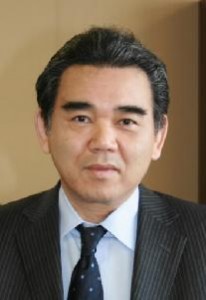Support and Ties in Face of Great Eastern Japan Earthquake: Making use of Hiroshima’s medical expertise involving treatment of radiation exposure
Apr. 5, 2011
by Naoya Kawai, Staff Writer
Dr. Mitsuo Ochi, 58, chief of medical affairs at Hiroshima University
In the wake of the crisis at the Fukushima No. 1 Nuclear Power Plant, precipitated by the earthquake and tsunami that struck eastern Japan on March 11, Hiroshima University has established the Emergency Radiation Exposure Countermeasures Committee at Hiroshima University Hospital. The university quickly dispatched a medical support team to the stricken area and has been making efforts to provide needed information to those affected by the disaster as well as local governments and the central government.
The many doctors and nurses that comprise the team are working hard at the site, believing that the medical expertise for radiation exposure which the university has accumulated over the years can now be effectively utilized. I sense the high hopes that the people in the affected area feel in connection with the healthcare professionals from Hiroshima, the A-bombed city.
As the director of Hiroshima University Hospital, I visited the city of Fukushima along with Kenji Kamiya, the director of Hiroshima University’s Research Institute for Radiation Biology and Medicine. We met with Yuhei Sato, the governor of Fukushima Prefecture, and Shinichi Kikuchi, the president of Fukushima Medical University, to offer our full support from this point forward.
Hiroshima University and Fukushima Medical University are moving to conclude a comprehensive agreement with regard to sufferers of radiation exposure. Hiroshima University plans to join hands with Fukushima Medical University not only to treat victims in the disaster zone, but also to pursue treatment practices for radiation exposure over the long-term.
In Fukushima Prefecture, the radiation dose beyond a radius of 30 kilometers from the nuclear power plant is not significant to the degree that it would impact human health. The medical support team has examined the thyroid glands of some 400 children to ascertain whether or not these children were exposed to radiation. The team found no abnormalities among them.
Due to a dearth of information, however, the current situation reveals that the residents of that area are feeling a mounting concern over radiation exposure that appears far greater than might be imagined. In this regard, Hiroshima University is also assuming the responsibility of conveying accurate information in a proper fashion. We are therefore determined to do our utmost and respond to this challenge proactively.
Profile: Mitsuo Ochi
Dr. Mitsuo Ochi joined the faculty of Hiroshima University as a professor in 2002, after working as a professor at Shimane Medical University (now, Shimane University). After taking up the post of vice director in 2004, Dr. Ochi assumed the position of director of Hiroshima University Hospital, a term lasting from 2007 to March 31, 2011. Dr. Ochi is a specialist in orthopedics and regenerative medicine.
(Originally published on April 1, 2011)
Dr. Mitsuo Ochi, 58, chief of medical affairs at Hiroshima University
In the wake of the crisis at the Fukushima No. 1 Nuclear Power Plant, precipitated by the earthquake and tsunami that struck eastern Japan on March 11, Hiroshima University has established the Emergency Radiation Exposure Countermeasures Committee at Hiroshima University Hospital. The university quickly dispatched a medical support team to the stricken area and has been making efforts to provide needed information to those affected by the disaster as well as local governments and the central government.
The many doctors and nurses that comprise the team are working hard at the site, believing that the medical expertise for radiation exposure which the university has accumulated over the years can now be effectively utilized. I sense the high hopes that the people in the affected area feel in connection with the healthcare professionals from Hiroshima, the A-bombed city.
As the director of Hiroshima University Hospital, I visited the city of Fukushima along with Kenji Kamiya, the director of Hiroshima University’s Research Institute for Radiation Biology and Medicine. We met with Yuhei Sato, the governor of Fukushima Prefecture, and Shinichi Kikuchi, the president of Fukushima Medical University, to offer our full support from this point forward.
Hiroshima University and Fukushima Medical University are moving to conclude a comprehensive agreement with regard to sufferers of radiation exposure. Hiroshima University plans to join hands with Fukushima Medical University not only to treat victims in the disaster zone, but also to pursue treatment practices for radiation exposure over the long-term.
In Fukushima Prefecture, the radiation dose beyond a radius of 30 kilometers from the nuclear power plant is not significant to the degree that it would impact human health. The medical support team has examined the thyroid glands of some 400 children to ascertain whether or not these children were exposed to radiation. The team found no abnormalities among them.
Due to a dearth of information, however, the current situation reveals that the residents of that area are feeling a mounting concern over radiation exposure that appears far greater than might be imagined. In this regard, Hiroshima University is also assuming the responsibility of conveying accurate information in a proper fashion. We are therefore determined to do our utmost and respond to this challenge proactively.
Profile: Mitsuo Ochi
Dr. Mitsuo Ochi joined the faculty of Hiroshima University as a professor in 2002, after working as a professor at Shimane Medical University (now, Shimane University). After taking up the post of vice director in 2004, Dr. Ochi assumed the position of director of Hiroshima University Hospital, a term lasting from 2007 to March 31, 2011. Dr. Ochi is a specialist in orthopedics and regenerative medicine.
(Originally published on April 1, 2011)








